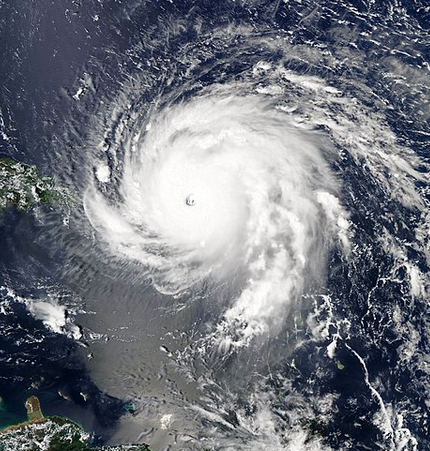‘Fog computing’ could improve communications during natural disasters
September 11, 2017

Hurricane Irma at peak intensity near the U.S. Virgin Islands on September 6, 2017 (credit: NOAA)
Researchers at the Georgia Institute of Technology have developed a system that uses edge computing (also known as fog computing) to deal with the loss of internet access in natural disasters such as hurricanes, tornados, and floods.
The idea is to create an ad hoc decentralized network that uses computing power built into mobile phones, routers, and other hardware to provide actionable data to emergency managers and first responders.
In a flooded area, for example, search and rescue personnel could continuously ping enabled phones, surveillance cameras, and “internet of things” devices in an area to determine their exact locations. That data could then be used to create density maps of people to prioritize and guide emergency response teams.
Situational awareness for first responders
“We believe fog computing can become a potent enabler of decentralized, local social sensing services that can operate when internet connectivity is constrained,” said Kishore Ramachandran, PhD, computer science professor at Georgia Tech and senior author of a paper presented in April this year at the 2nd International Workshop on Social Sensing*.
“This capability will provide first responders and others with the level of situational awareness they need to make effective decisions in emergency situations.”
The team has proposed a generic software architecture for social sensing applications that is capable of exploiting the fog-enabled devices. The design has three components: a central management function that resides in the cloud, a data processing element placed in the fog infrastructure, and a sensing component on the user’s device.
Beyond emergency response during natural disasters, the team believes its proposed fog architecture can also benefit communities with limited or no internet access — for public transportation management, job recruitment, and housing, for example.
To monitor far-flung devices in areas with no internet access, a bus or other vehicle could be outfitted with fog-enabled sensing capabilities, the team suggests. As it travels in remote areas, it would collect data from sensing devices. Once in range of internet connectivity, the “data mule” bus would upload that information to centralized cloud-based platforms.
* “Social sensing has emerged as a new paradigm for collecting sensory measurements by means of “crowd-sourcing” sensory data collection tasks to a human population. Humans can act as sensor carriers (e.g., carrying GPS devices that share location data), sensor operators (e.g., taking pictures with smart phones), or as sensors themselves (e.g., sharing their observations on Twitter). The proliferation of sensors in the possession of the average individual, together with the popularity of social networks that allow massive information dissemination, heralds an era of social sensing that brings about new research challenges and opportunities in this emerging field.” — SocialSens2017